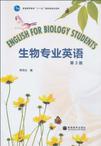生物专业英语
出版时间:2010-3 出版社:高等教育出版社 作者:蒋悟生 页数:285 字数:450000
Tag标签:无
前言
21世纪是生命科学飞速发展的世纪,新知识、新方法、新概念不断涌现。为了更好地学习和运用专业科学知识,借鉴国内外的研究成果,从事具有创新性的科学研究,同时进行国际科技交流与合作,编者根据高等教育大力培养创业和创新人才的需要,编写这本教材,奉献给广大读者。 本教材共15课,1-10课由课文(Lesson)、课后练习(Exercises)、拓展信息(Additional Information)、阅读理解(Reading Comprehension)和阅读材料(ReadingMaterials)5部分组成,11-15课由阅读材料(Lesson)和拓展信息(Additional Information)组成。书后附有练习答案和词汇表。教材涉及细胞生物学、遗传学、动物学、植物学、微生物学、生态学、分子生物学、物种起源与进化、环境科学、情报科学、论文写作等内容。 本教材的特点在于:①注重专业词汇的积累。目前大学生、研究生都具有大学英语四、六级的水平,并已掌握了基本的英语语法,但他们在阅读生物专业英文书刊时仍感到异常费力。分析其主要原因,除了学生自身专业知识面较窄外,更重要的是他们对专业词汇了解甚少。书刊中专业词汇重复率的高低直接影响到阅读理解的速度及阅读兴趣。因此,编者在编写时注意文章中专业词汇的重复性。首先把课文中最初出现的重要的生物学词汇以黑体标注,依次在注释中对词汇或短语加注国际音标,并用中英文加以注释,最后在书后附有词汇表,便于学生自学。每课阅读材料中提供了与课文相应的内容和课后练习,帮助学生巩固、加深对课文的理解和专业词汇的记忆。②注重专业文献阅读、文献检索及论文写作能力的提高。阅读专业英文书刊的能力、科技文献检索能力及研究论文的写作能力是保证学生未来在各自研究领域成功地进行高水平科学研究的关键。本书在这些方面为读者提供了学习和实践环境。在补充材料和配套网站(Companion Websire)内容的选择上,编者有意挑选研究论文写作、投稿、文献检索与利用等方面的资料,试图通过这些内容帮助学生掌握论文写作和文献检索知识。③选材具有实用性、可读性和趣味性。本书所选材料力图提高学生学习的兴趣,帮助他们尽快掌握专业英语书刊的阅读技巧、了解文献检索及写作知识。④内容涉及面广,难易适度。本教材力求反映现代生物学的发展趋势,取材新颖。内容取材于国外原版教材、专业学术期刊、Internet网上资源等。
内容概要
本书内客涉及细胞生物学、遗传学、动物学、植物学、微生物学、生态学、分子生物学、物种起源与进化、环境科学等。全书共15课,由课文、课后练习、拓展信息、阅读理解和弼读材料等部分组成。书后附有练习答案、词汇表、参考文献。内容涉及面广取材新颖,难易适度,充分反映现代生物学的发展趋势。 在前2版的基础上更新了部分较为陈旧的阅读材料,着重补充研究论文写作、投稿、文献检索与利用等方面的资料。为了更好地帮助学生学习,编者在与本书配套的网站(Companion Website)上提供了许多教学资源网络链接,以多种教学形式帮助读者有效利用Web of Knowledge,Web of Science Journa Citation Reports,Elsevier ScienceDirect,ProQuest等国际重要文献数据库。 本书可作为高校生物类专业英语教材,也可作为从事生物、农林、环境科学等领域科研工作的人员的参考工具书。
书籍目录
Lesson One Inside the Living Cell: Structure and Function of Internal Cell PartsLesson Two PhotosynthesisLesson Three Cellular Reproduction: Mitosis and meiosisLesson Four Foundations of GeneticsLesson Five Discovering the Chemical Nature of the GeneLesson Six The Origin and Diversity of LifeLesson Seven Fungi: The Great DecomposersLesson Eight Animal DevelopmentLesson Nine The Origin of SpeciesLesson Ten The Ecology of PopulationsLesson Eleven Plant Biology Research Comes of Age in ChinaLesson Twelve The ISI Web of Knowledge Sm Platform: CurrentLesson Thirteen Assessing Potential Dietary Toxicity of Heavy Metals in Selected Vegetables and Food CropsLesson Fourteen A Roadmap of Cancer cystems Biology Lesson Fifteen Hyperaccumulation of Cadmium by Roots, Bulbs and Shoots of Garlic (Allium sativum L.)Answers to ExercisesGlossary of Biological TermsReferences
章节摘录
In other groups of organisms, hybrids do not form between species of a particular genus(plural genera, a group of related species), or such hybrids are generally sterile. In some groupsof organisms, even local populations are sometimes not capable of interbreeding with one another.This pattern occurs, for example, in many groups of annual plants. For still other kinds of plantsand animals, we do not know whether the species are capable of forming hybrids or not. In practice, scientists usually recognize species primarily because they differ from one anotherin their features, not by the presence of breeding barriers. For these reasons modern biologistsdefine a species as a group of organisms that is unlike other such groups of organisms and does notnormally interbreed extensively with those other groups in nature, although they may do so underartificial conditions.The path from microevolutionary change within a species to the divergence of that species into twoseparate species involves the division of a group of similar individuals into two groups that usuallyare less similar. The new species usually do not interbreed with one another, either because theyare incapable of doing so or because the nature of their occurrence prevents them from doing so.We refer to the separation of a species into dissimilar groups as divergence, and to the mechanismsthat prevent successful mating as reprodttctive isolating mechanisms. We shall consider divergencefirst.
图书封面
图书标签Tags
无
评论、评分、阅读与下载
用户评论 (总计0条)
推荐图书
- 中考英语怎么考/英语考试系列丛书
- 高考英语怎么考?
- 煤矿安全培训教材.煤矿安全管理
- 20几岁一定要悟透的50个成功智慧
- 掌心里的恋人
- 忘记你,时间难以治愈的伤
- 牧草饲料加工与贮藏
- 中国政坛上的桂系
- 江浙沪古镇自驾游
- 本田新雅阁轿车维修一本通
- 精巧盆景动动手
- 新编孕产育儿必读
- 青春期调养100招
- 失眠调养100招
- 抑郁症调养100招
- 你不可不知的培养完美女儿100招
- 你不可不知的100种减肥塑身妙招
- 看图学万用表使用快速入门
- 纺织品 色牢度试验 标准贴衬织物(第3部分):聚酰胺纤维 (平装)
- 纺织品 织物撕破性能(第1部分):冲击摆锤法撕破强力的测定 (平装)
- 纺织品 色牢度试验 耐家庭和商业洗涤色牢度使用含有低温漂白活性剂的无磷标准洗涤剂的氧化漂白反应 (平装)
- 女性求职全攻略
- 披肩与开衫编织
- 女士毛衣编织
- 基础会计
